A detailed review of the new generation MacBook Pro (with Retina display)

Salute, Earthlings!
I found that there is no post on the Habré, which will unite everything that you need to know about this miracle computer. Therefore, I decided to thoroughly approach the analysis of user experience, hardware, performance, and other impressions. After a month of full and independent use, I am ready to present you ...
Many of you who were interested in the novelty, probably watched the promotional video of this product from the creators:
')
Full HD video (english)

In the promotional video the main focus is on the display, and only then on the design and computing power. As you may have guessed, this is no accident.
Let the imagination without any difficulties succumb to the figure of 2880x1800 pixels, but to fully appreciate what 5 million dots by 15 inches can only be after working at the computer for a while. After working with a laptop, especially after long work, the only thing that manifests itself is a characteristic incident for Retina screens - 100% addiction to a new quality. Do you have a high-density mobile device? So you must have come across the awkward feeling of “seeing pixels instead of letters” when you looked at your granny's phone with the standard 72 PPI. My first experience was two years ago: for the first time I picked up an iPhone 4 with a Retina screen, I instantly realized - yes, this is the future standard for all manufacturers, because such a screen is very pleasing to the eye! Now, let's scale it all up to a laptop and get the same Deja Vu that I experienced sitting down for the new MBPr. This is the same standard, but in its next, no less beautiful embodiment.
Of course, I did not discover America, of course, but simply tried to describe all the logic of impressions that you will definitely feel in your own way ... it will be a MacBook Pro Retina or any other computer with similar technology.
In Apple presentations you could come across various visual comparisons:

So, the most abundant salivation awaits those who are interested in photography and design. When you open your favorite photos on a new screen, they will instantly gain a new meaning, and I declare it with full responsibility. If earlier on the screen with a resolution of 1920x1200, any photo in the resolution, for example 3840x2400, lost its depth in fullscreen mode (this is when 4 pixels were replaced by one by means of hardware compression), now the photos are revealed 200% of the expectations. This is especially evident in the photo where there are small parts, animal hair, grass in the background, etc. Now there is no ladder of pixels, which destroys the smoothness of a curved line and kills small bends, now there are pure bends in any proportions and this is striking. Striking to the very depth of perception!
This digression in the form of impressions was necessary, since the screen deserves attention from all sides. Now I want to tell you more about the screen that is mentioned briefly in the presentations.
For a start, I would like to mention such a pleasant trifle as smoothness when changing the brightness of the display; it now changes not in jerks, but smoothly, as if you were adding brightness to the iPhone, smoothly moving the slider. Nuance is small, but it looks great. And the highlight of the program, of course, is the IPS matrix. This decision allowed Apple designers to make a number of important improvements. First, the cap is now much thinner (4 mm). This was achieved by removing the extra glass layers and gluing the parts together so that the problem of glare on the glossy screen could be solved a little less than completely. Let's take a closer look at this issue. After all, I - like many other owners of matte screens - was very worried about this issue.
For a start, a photo comparison of the screens of two different generations:

"It still flashes!" - You say. “The computers are turned off in the photo” - I will answer. Everything with highlights on the new screen is in order. In other words: I, as a user of matte screens in three generations of MBP, (started with the PowerBook G4) - never disappointed their new anti-reflective coating in the alloy with a new glass bonding technology about which they sing in the promotional video. The screen is really resistant to light extremes and artifacts. If you have a window without curtains right behind you, then on a sunny day, it will probably cause inconvenience when the screen brightness is below 50%, but by and large it should not be distracting, I experimented in the most extreme conditions and stopped noticing the brightest light bulbs . The main anti-glare trump card screen is not even a coating, but the contrast and black level, by the way, about them:

The brightness seems to be lowered - compared to last year’s model; but improvements in black levels make this loss inconspicuous. Since the contrast has taken a huge step forward! Due to the combination of the above indicators, the problem of glare, in my opinion, was solved. I did not form such an estimated opinion at the expense of figures, of course, but at the expense of personal feelings following the results of working at a computer for a long period.
The grid density in the new MBP is 220 PPI, on the iPhone - 326 PPI; the difference of 100 pixels is quite distinguishable when comparing:
Both pictures in scale 1: 1 // 640 x 960 px
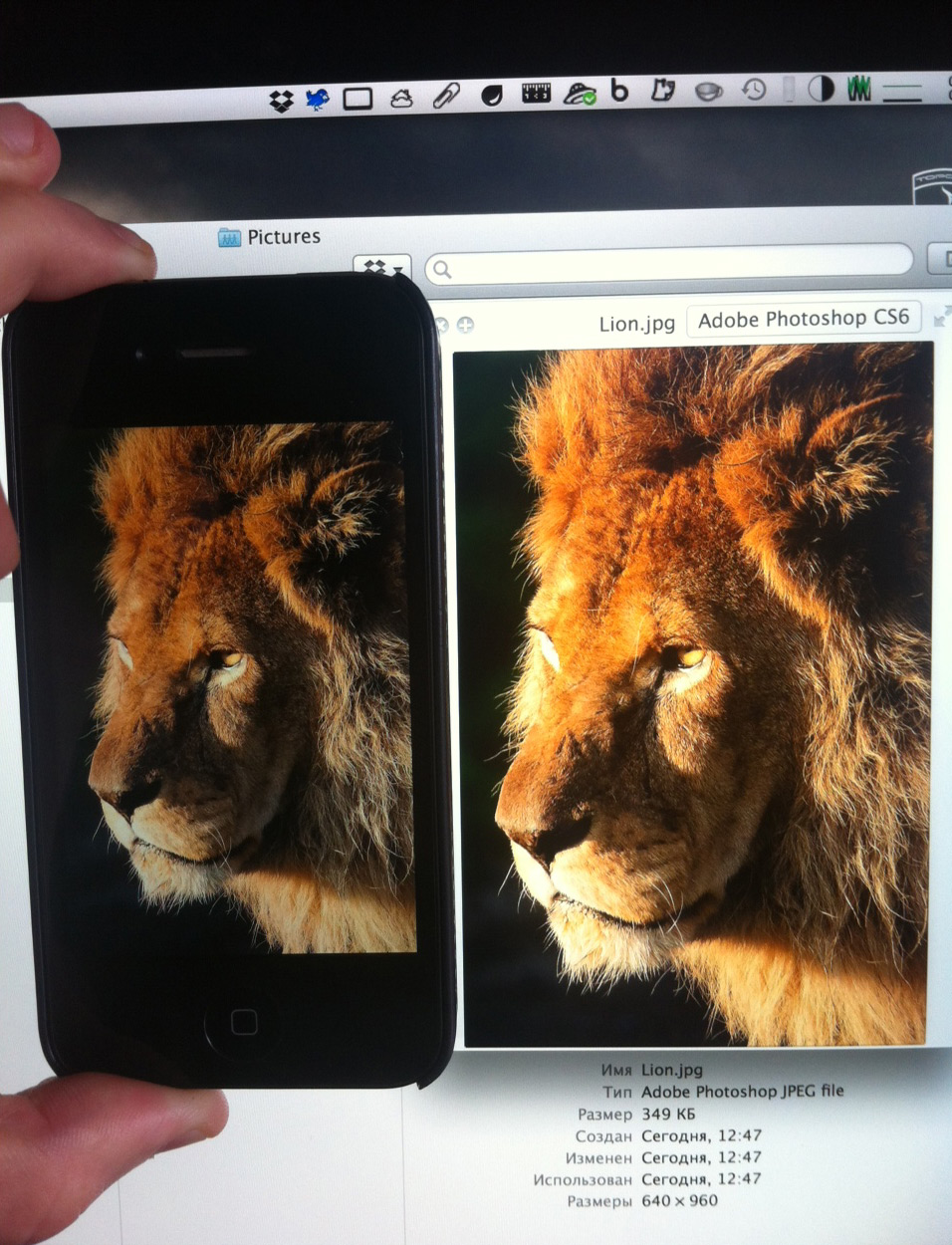
But "by sight" this difference, in reality, is not perceptible. Thus, the marketing mulka “Retina” fully justifies itself.

After the summer presentation, I was indignant, no, I was as disappointed as possible when I realized that the 17 "MBPretina would not have to wait. For me, it was a blow from my breath, since my three previous laptops were 17-inch (professional necessity). I even started thinking that Apple is no longer a cake, that they scored on professionals and are increasingly thinking of housewives ... BUT no. Fortunately, I made a mistake. As soon as I got to the window with MBP - first thing (after sighing and yahoo) - I got into monitor settings, there was a pleasant surprise waiting for me:

It is worth paying tribute to the guys from Cupertino, those who were responsible for adapting OS X to the new display did their best! Not only did they very carefully draw the OS itself, so they thought up scaling on the screen so that they simply had nothing to complain about. Scanning is not given on a scale of 1: 1 (2880x1800), but in an excellent form it simulates all the scales customary for the present (screen links on screenshots):
- 1024 x 640 - apparently this option is just for symmetry, I did not understand it
- 1280 x 800 - for reading, leaning back in the chair when the computer is on the table
- 1440 x 900 - recommended (standard for 15 "models of past generations)
- 1680 x 1050 - Workspace 15 "version of the previous generation with a matte screen
- 1920 x 1200 - Here it is the fish of my dreams! Analog 17 "scan.
Thus, choosing the mode “Looks like 1920 x 1200”, the workspace begins to fully correspond to my usual semishka. To the possible question “is it too small?” I will answer this way: you can see better than before by an order of magnitude! This is Retina ... The difference in inches is almost not felt, let me remind you that this difference is not 2 "but symbolic 1.6", since the real diagonal of the working area of the display is 15.4 ". Nevertheless, situations when something in the browser looks a bit small happens , and if earlier I had to increase the scale, now I can just bend down to the screen at a distance of 20 cm and look at the rest, holding my breath, because the pixel grid is barely visible even from a distance of 10 cm.
Lifehack: The GPU is so programmed that when you select any of the scales, the video card generates an image four times the standard scale. In other words: if you choose the organization of space as 1440 x 900 (recommended), then the GPU generates a pixel to a pixel double magnification, it is 2880 by 1800. But if you choose 1920 x 1200, then the original render corresponds to a resolution of 3840 x 2400 px, now - just taking a screenshot from the screen - you can send A4 to print without additional prepress preparation (of course, if your typewriter is modern and it has a sane PostScript compiler that easily cheats RGB)

Most of all, the lack of readiness for the future trend is felt in the Internet environment. Yes, the number of sites “ready for Retina” is negligible, even www.apple.com is not completely finished. But it is a matter of time, as the trend will soon begin to confidently advance on all fronts, when Apple's competitors start producing products with similar solutions. In my opinion: it’s not so difficult to maintain this standard ... According to my calculations, the base of such a site as Habr will take a day on the Retina standard. By the way: all projects that we will soon be releasing from the walls of our small studio will be ready for a new format, and who if not us? We, the residents and designers of the Internet, have everything and even more for this ... desire, for example.
Of course, the very first supplier of rendered applications are Apple themselves, everything is fine inside the system. For a month I did not find a single joint. Software manufacturers are not far behind. There is even a site that is dedicated to applications ready for the future standard. He quite comprehensively answers the question of what is ready and what is not. Along with this, some applications do not initially require support, as they are constructed on the principle of vector graphics. For example iStat menus , an extremely useful utility got up as it should, and in the announcements about Retina not a word.
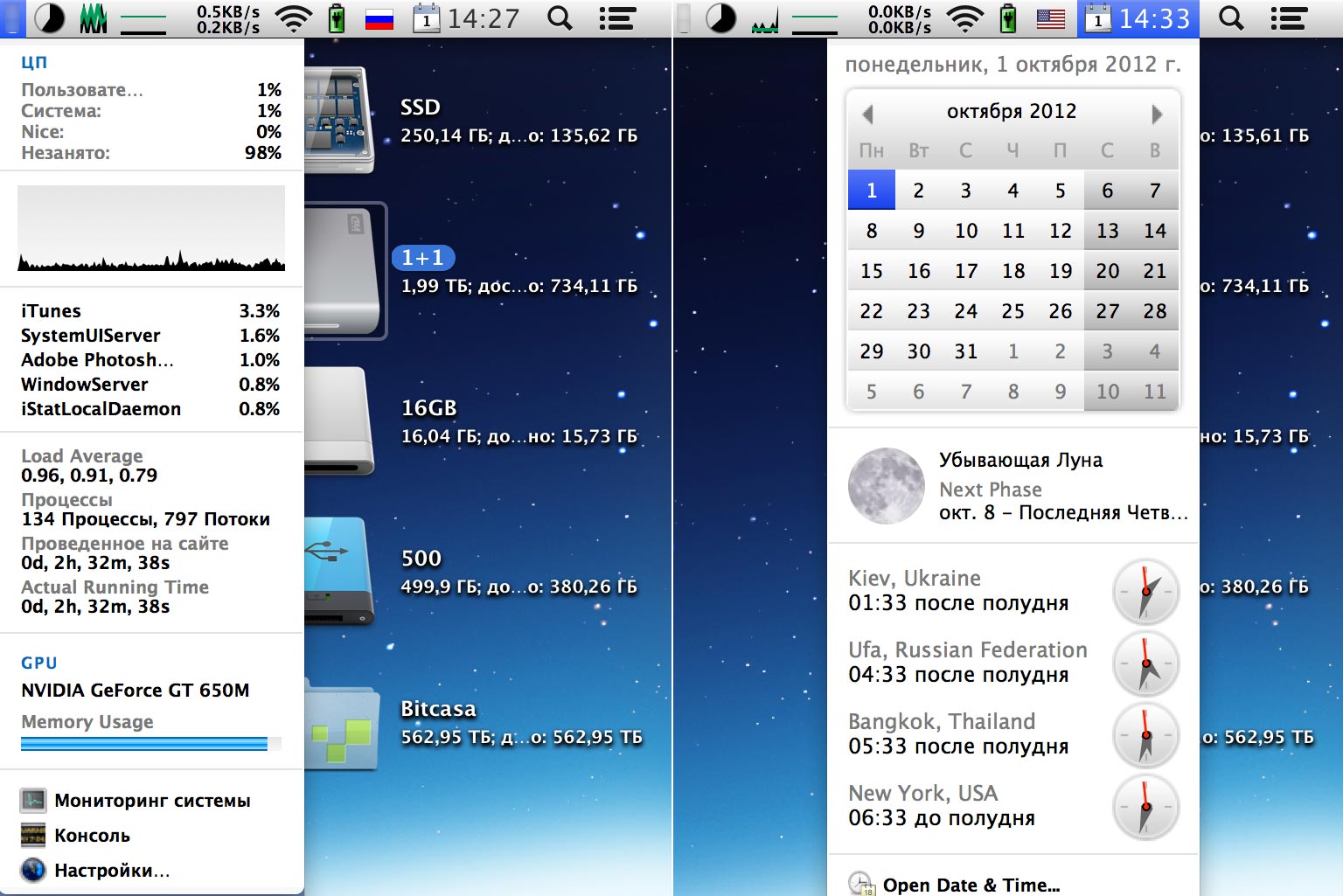
But Adobe in the best traditions of the genre collects the rays of hatred. Yes, the Creative Suite 6 software package is absolutely not ready for the future standard, even in the little things and the most recent contextual menus, pixels crawl outward, which look more tolerable in the “Like 1920 x 1200” mode of operation, but still noticeable, due to my service A lot of work with these applications:

The Adobe blog has a whole topic and promises that they are now very actively working on the proper update, which should be released very soon (in the fall). We wait. Believe it. We tolerate this disgrace:

For an estimate of the scale of a disaster, I recommend to look at a 1: 1 image.
If you are interested in looking at Windows 7 in the resolution of 3840x2400, go here .
Another example of how awful Retina-ready apps can look. Additionally, it grieves that the official Twitter client for MacOS is no longer supported. I had to switch to paid Twitterrific .
Summary: no matter how eloquent the description of the screen is, I think you will agree that it’s better to see once than to hear a hundred times. Personally, I understood everything without words, when I took my favorite photo-wallpaper (in the most accessible HD) + distributions of necessary programs, walked to the nearest showcase where this strange beast is exposed, and I found everything using the “spear” method, by the way, I recommend you . The three pictures look the most enchanting, I prepared them from very high quality sources. Take with you, they will reveal to you the charm of the new display.
I warn you! If you do this and get carried away (for an hour or two stick at the new screen), then you can no longer look at your real monitor. Checked by a group of people with visual perception of the world.

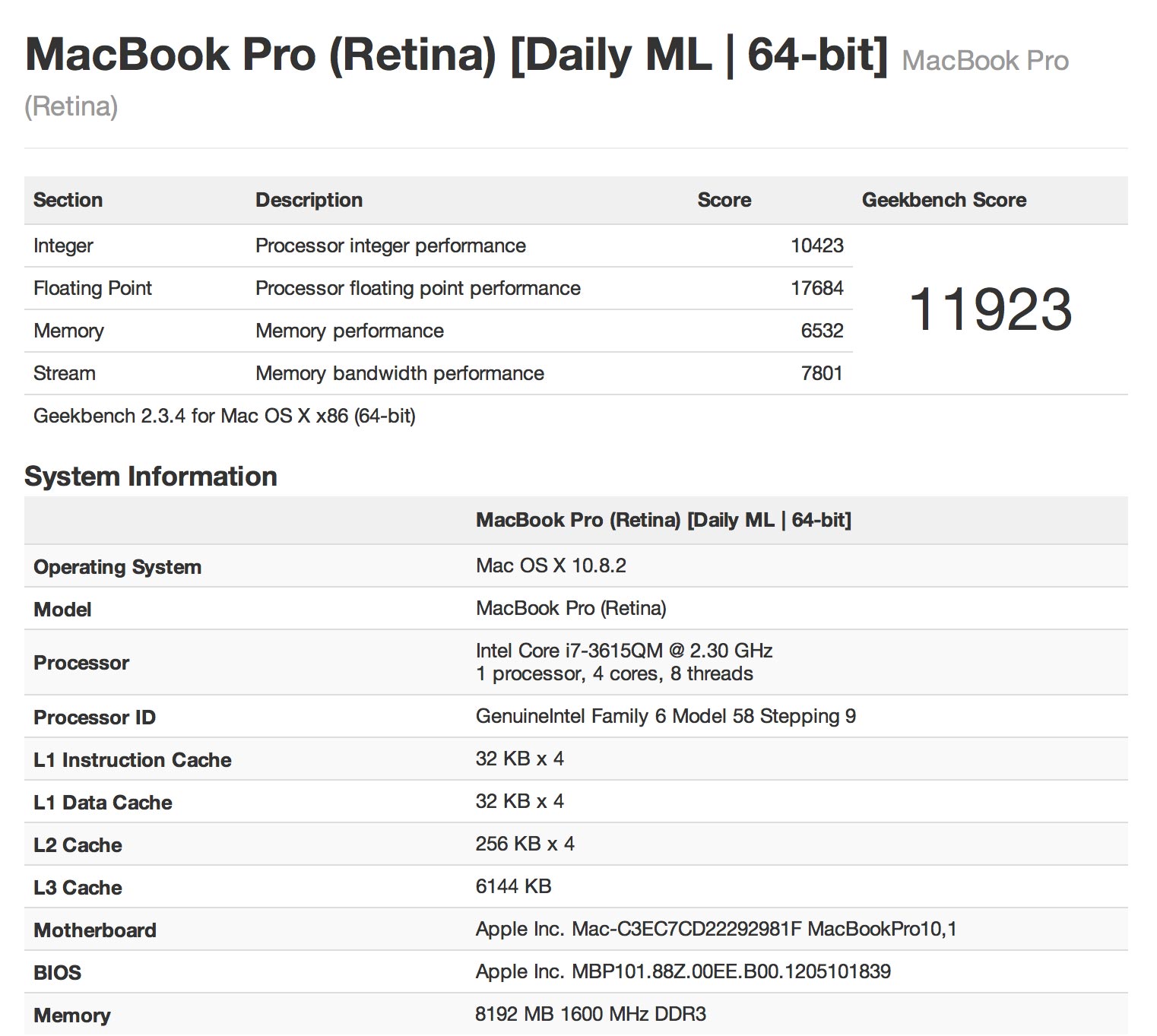
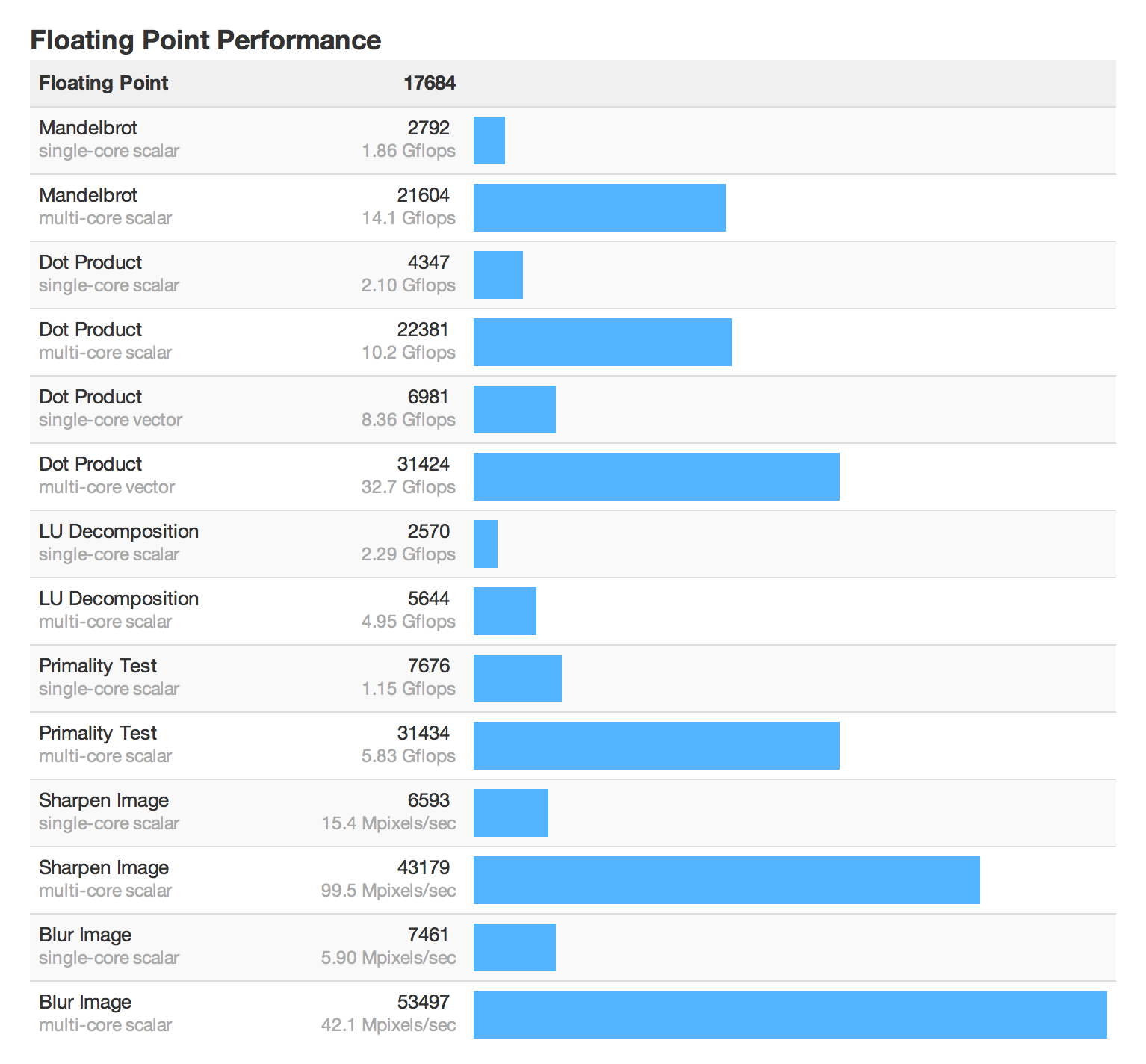

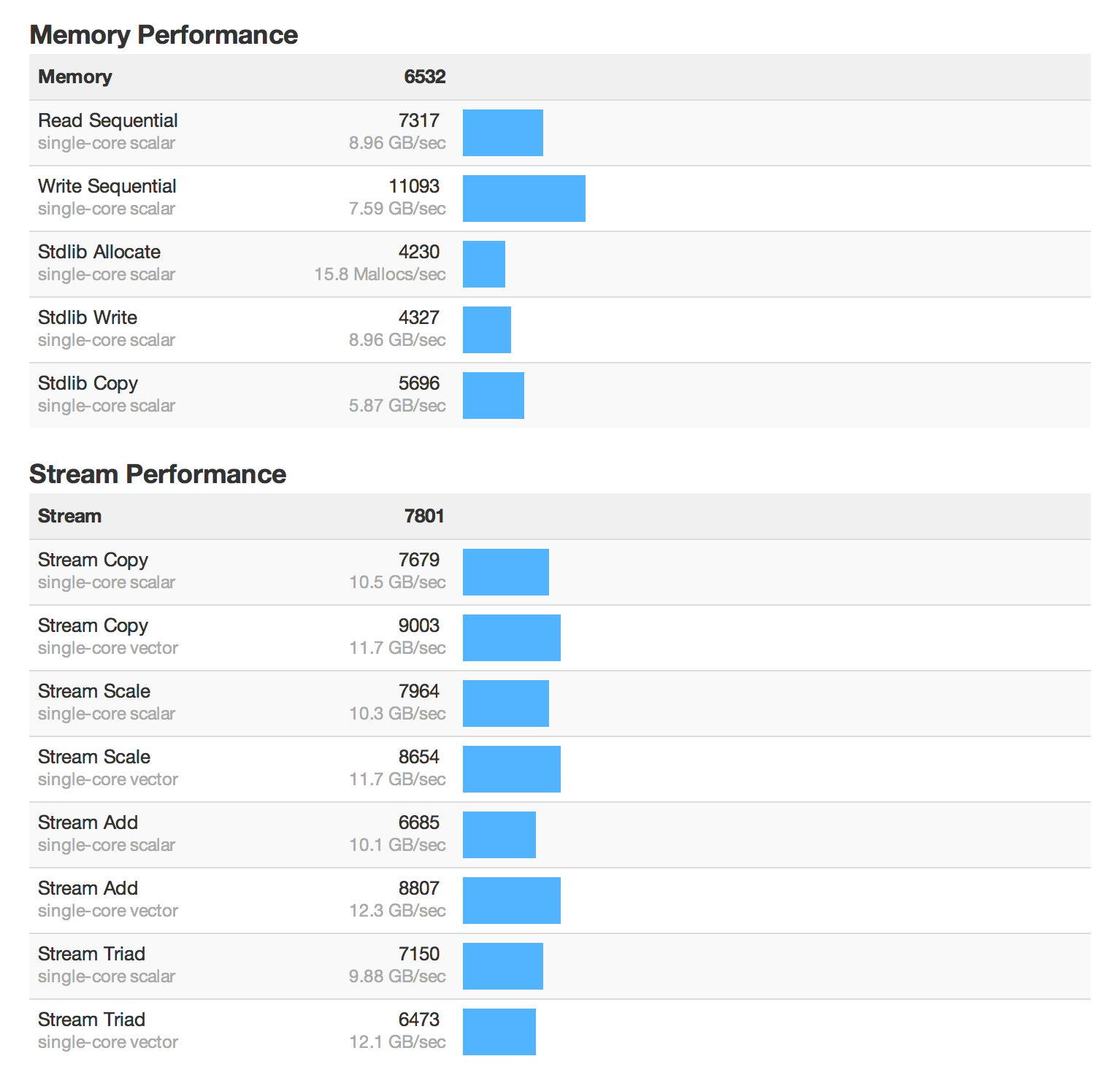
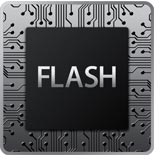 The transition to the Flash architecture perfectly manifested itself even in the days of the appearance of the MacBook Air, it was already clear that SSD had the future of mobile computers and, in general, productive computers in general. Since it is the SSDs that provide the minimum power consumption and weight, the excellent data exchange rate is not heated at all. There is only one drawback - the cost. That is why in the basic configuration of the new MacBook Pro, we see a small 256GB drive. For me, this was a definite test, since I could not afford 512 or 768Gb (I did not see the point) for such money. In the previous notebook I had SSD 80Gb + HDD 1Tb . Therefore, I was faced with the task of finding a compromise: how to take with you everything that is necessary, and at the same time not limit yourself to the level of inconvenience. I found several solutions: firstly, this is cloud data storage. For example, Bitcasa 562 terrabayta (native, but for $ 49, the first month is free) . There I transferred all the working archives (180GB) that may be needed on the road, since my external hard drive is too big to take with me. The second solution is:
The transition to the Flash architecture perfectly manifested itself even in the days of the appearance of the MacBook Air, it was already clear that SSD had the future of mobile computers and, in general, productive computers in general. Since it is the SSDs that provide the minimum power consumption and weight, the excellent data exchange rate is not heated at all. There is only one drawback - the cost. That is why in the basic configuration of the new MacBook Pro, we see a small 256GB drive. For me, this was a definite test, since I could not afford 512 or 768Gb (I did not see the point) for such money. In the previous notebook I had SSD 80Gb + HDD 1Tb . Therefore, I was faced with the task of finding a compromise: how to take with you everything that is necessary, and at the same time not limit yourself to the level of inconvenience. I found several solutions: firstly, this is cloud data storage. For example, Bitcasa 562 terrabayta (native, but for $ 49, the first month is free) . There I transferred all the working archives (180GB) that may be needed on the road, since my external hard drive is too big to take with me. The second solution is:
The technology is very promising, Wikipedia says that this standard has a capacity of up to 2Tb, cards for 256 Gb are now announced, cost $ 800, but we all know that flash memory is getting cheaper and stable. Therefore, the imputed value is a matter of time. Not far off is the moment when it will be possible to buy 512Gb for yourself and carry everything in your purse. I tested the work of SanDisk on 128Gb 10 class, gives an honest 45Mb / s in both directions. Available on eBay for $ 145.99 today.
Everything is good, but I had to look for a compromise with music. Alas, none of the above solutions were suitable for my Lossless collection of 450Gb, then I had to transfer everything to an external hard drive. In order for it not to occupy one of the two USB, I bought a FireWire> Thunderbolt adapter , so the external databank still runs at 85Mb / s.
The built-in SSD works fairly quickly:

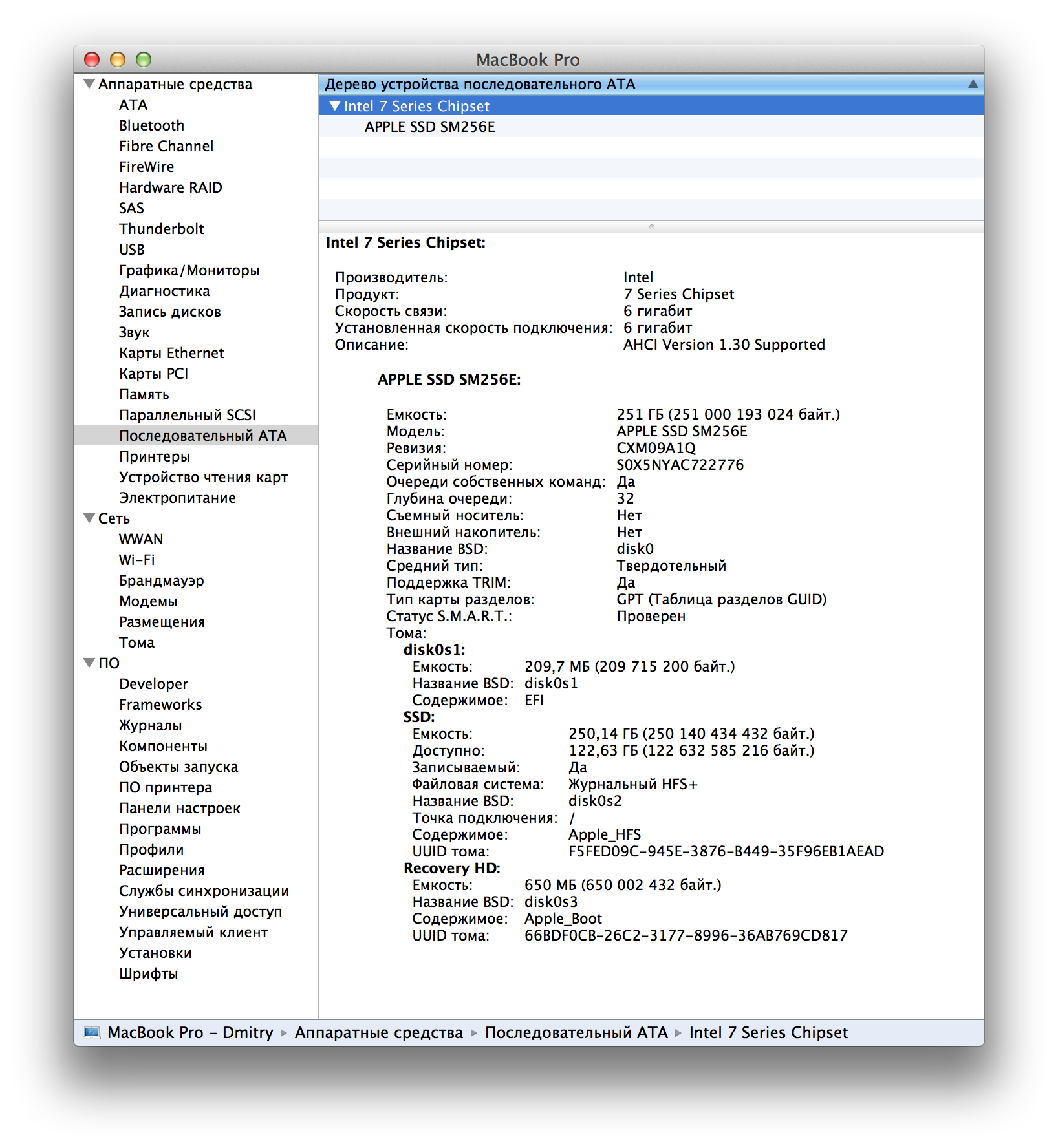
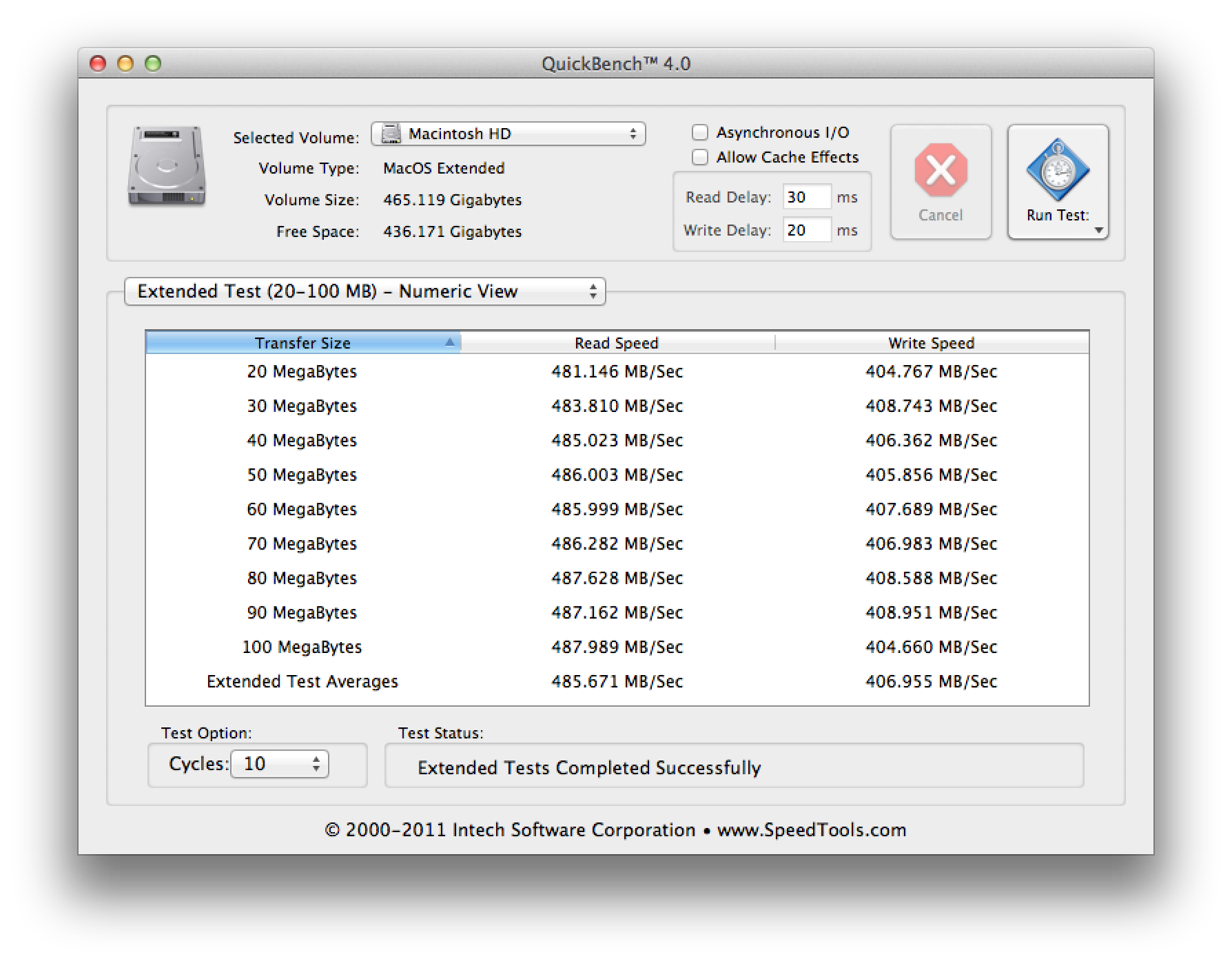 As you can see almost 500 megabytes per second, with both ways. This puts the integrated SSD in a single line with the Intel 520 series and the latest OCZ people's models. I can give two examples of how this is reflected in the work - when the computer boots, this screen appears:
As you can see almost 500 megabytes per second, with both ways. This puts the integrated SSD in a single line with the Intel 520 series and the latest OCZ people's models. I can give two examples of how this is reflected in the work - when the computer boots, this screen appears:
The merry-go-round under the apple does not have time to make one revolution as the Desktop appears.
The second illustrative example is the speed of QuickView, if you open 100+ RAW files with photos via Quick view, then earlier (on the HDD) you had to wait decently until the previews were loaded:

Now it happens instantly if the photos are on an SSD disk. With an average size of one image ≈ 12 mb.
Tests! More tests !!! (everything is clickable)


But high speeds are not only in SSDs, USB 3.0 will delight in excellent speed, of course, if you connect a regular HDD with a speed of 5400rpm, you will not need to rely more than 54Mb / s, but if you connect Intel x25M SSD, you will get a return on 146% its capabilities:

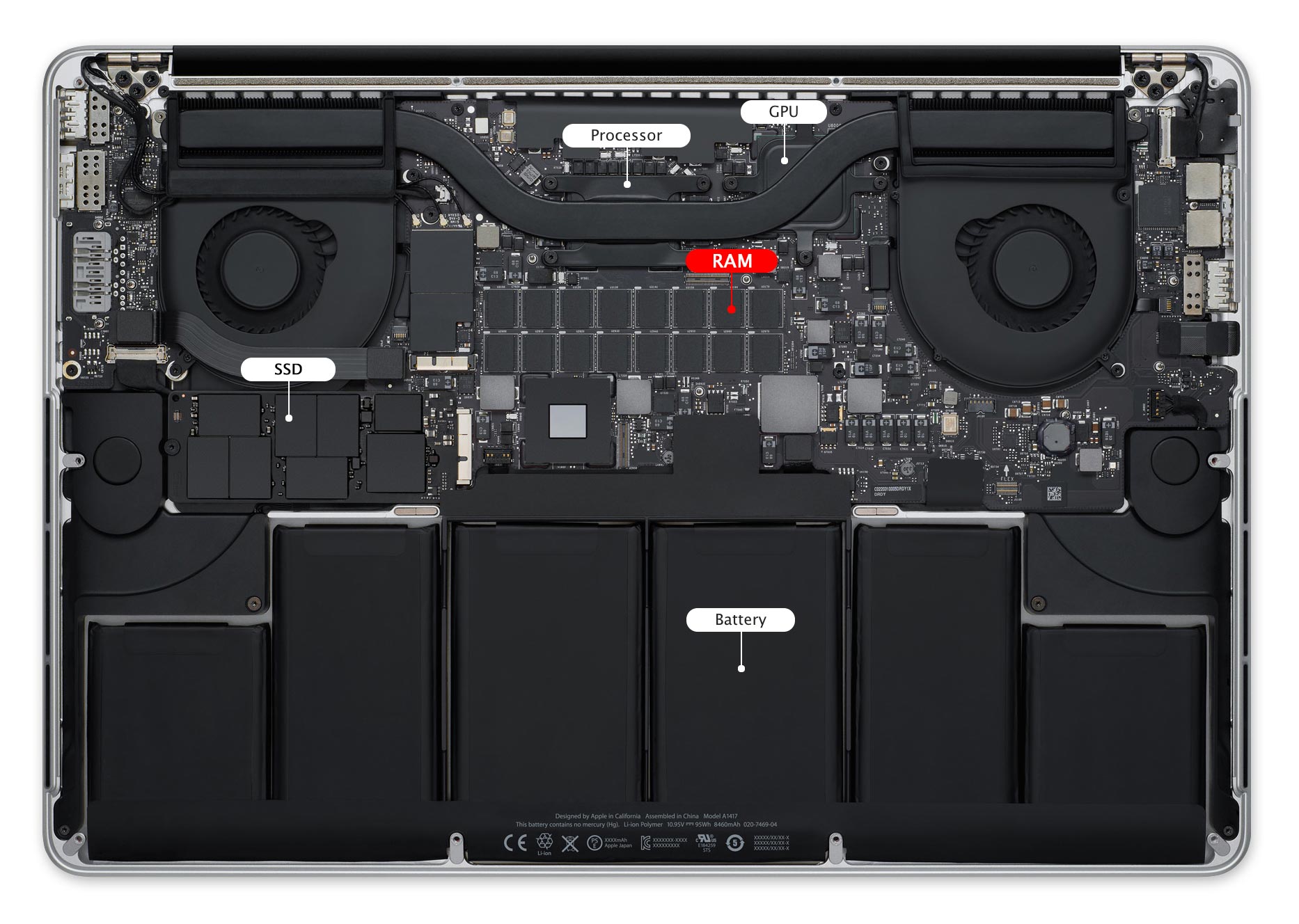
 Then I will tell you a story about RAM. You probably know that in order to make the laptop lighter and thinner, the guys from Apple had to make compromises, one of which was the crossed out concept of “
Then I will tell you a story about RAM. You probably know that in order to make the laptop lighter and thinner, the guys from Apple had to make compromises, one of which was the crossed out concept of “ In order: I got a lucky chance, my close friend flies to the US as a flight attendant and agreed to buy me a laptop right there. Initially, I asked her to buy a basic package with only one option - 16Gb SDRAM, since if you wish, you can still replace the SSD (by purchasing a branded SSD on eBay with the right amount), but you buy the memory once and for all. It's hard to believe, but she visited three stores for three flights, in Miami, in Los Angeles and in New York. ANYWHERE there are only two complete sets: basic and a complete set for $ 3700 (i.e. maximum). Any other, especially the one I wanted, is to be waited from one month, since it will be specially taken from the factory for the order. Time unfortunately was not and I had to take the base. Therefore, if you decide to take a laptop with options: keep in mind, if the required version is not available, you will have to wait a long time. Also applicable if you intend to buy in Russia. For the experiment, I turned to Formoza, they said that they could bring the necessary equipment in 45 days, because they would order it from the USA, which fully confirmed my conclusions, which I decided to share with you. Forewarned is forearmed!
So, I have 8Gb and I thought that this could affect performance, as in the previous notebook with the same indicator - there was not enough memory from time to time, especially when 100500 tabs were opened in Safari, Windows in Parallels, Mac Office 2011 and half of the package CS6. But fortunately enough. The memory is really very fast. 1600MHz make themselves felt and strangely enough almost all the time I have free 1Gb +. Problems with the shortage of the month I have not felt even once. The whirling beach ball of death was also spotted.
Nevertheless, if you are planning to perform complex 3D rendering and editing of films, then you should think about ordering a model with 16Gb and a cooler processor.

The third-generation Intel Core i7 Ivy Bridge processors are based on a 22 nm microarchitecture and provide simultaneous operation of two threads on each core. Thus 8 flows turn out. Before that, I had i7 with two cores (4 threads) and it was only 99% possible to load it with a compilation of video files. Now, nothing has changed. It is possible to load the processor by more than 50% only with the help of Flash, by more than 75% only with games and with the conversion / rendering of video files.
With the GPU, everything is not so bright. Despite the fact that the notebook is really a powerful card NVIDIA GeForce GT 650M 1024 MB:

I have already mentioned that I work in the “Like 1920 x 1200” mode, while the layout of the GPU renders the resolution 3840x2400 and it has a hard time. The load is almost always 100%. The interface slows down occasionally, in the form of shaking when you call Mission Control. FPS drops, but the system response does not change. Therefore, not very annoying.
I saw the work of the integrated Intel HD Graphics 4000 only a couple of times when I was working with a battery and running ≈ 6 applications, of which the most difficult was Safari.
Here is the standard picture of the CPU and GPU load:
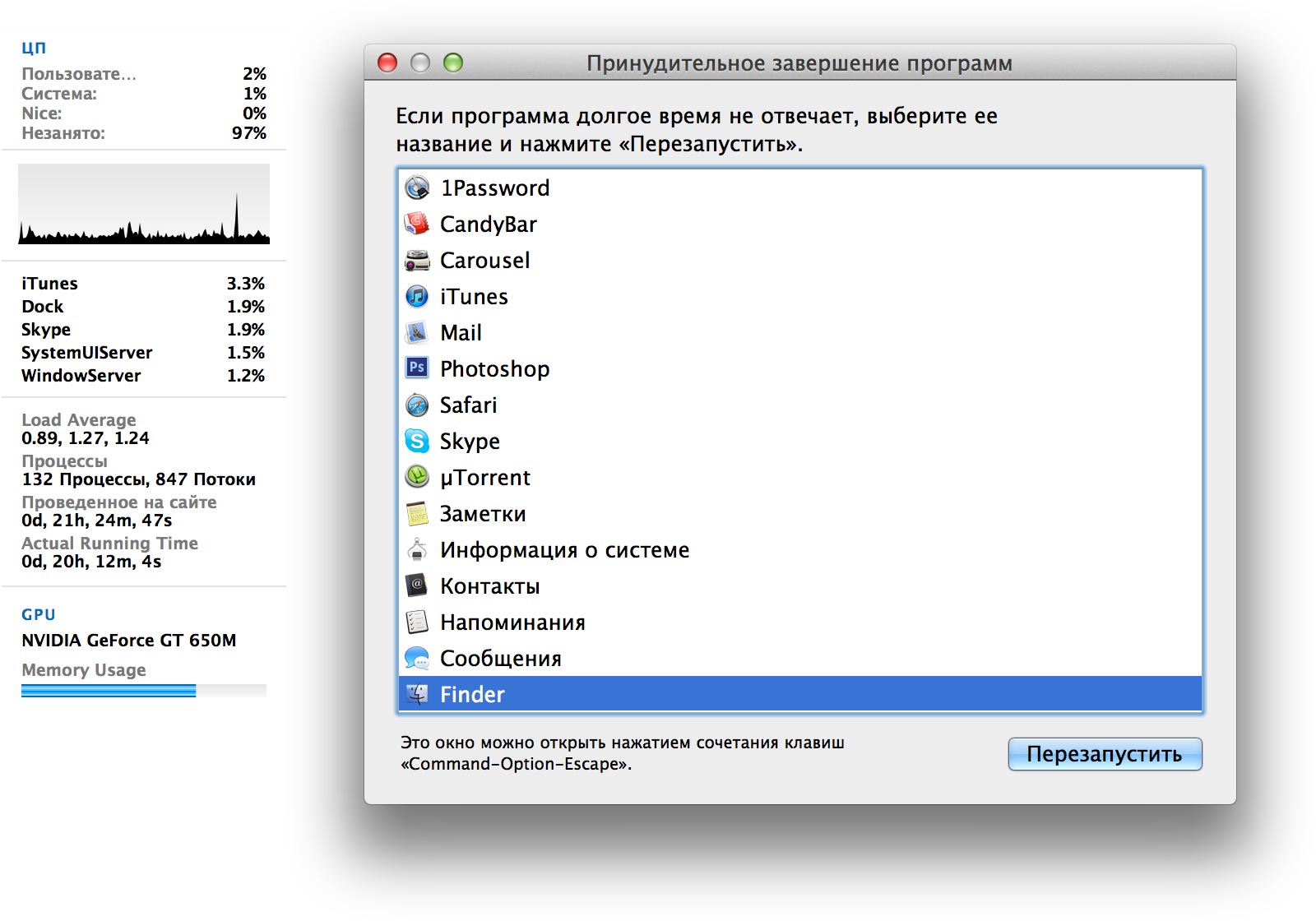
Nevertheless, it is worth noting that the GPU copes with games. Tested on Diablo 3 and at last Deus Ex. In both cases, the lags are minimal, FPS stays around 40 (this is if you choose 1920 x 1200 resolution in the game with vertical synchronization), if you choose 2800 × 1800, then ≈ 20-25 FPS. Games like Starcraft 2 and World of Warcraft do not slow down at all.
In conclusion, it can be noted that 3 external monitors have already been connected to the laptop, which he coped with .

About the battery I can note that it is really hardy:
- 7h 23 min • Web browser + Wi-Fi // 60% of screen brightness
- 5h 39 min • Web browser + Flash + Wi-Fi // 75% of screen brightness
- 3h 08 min • High load (Parallels, CS6, Web-serfing, MS Office 2011) // 75% screen brightness
- 2h 27 min • Total load (Diablo 3) // 100% screen brightness

Improving the quality of the camera was manifested in one thing (I apologize in advance for being frank) if earlier, due to noise, skin defects were visible, sometimes even stronger than real and literally conspicuous, now there is no such problem. The image is smooth enough so that even with room lighting, the noise in the image was very low.
The sound of the speakers is better compared to the previous generation of MBP. The sound is more dull and smooth. Bass became brighter and deeper. High frequencies have become smoother ... But in general: as a standard option, for presentations or Skype-conferences is quite suitable. Watch movies with dialogue - too. For the presentation of a good track or blockbuster - not sure.

Asymmetric coolers are pleased! Their noise was not that much quieter. He has become different. When they work in the standard mode - they are absolutely unheard of, even with complete silence in the room, in other cases it was like this before, only external HDDs are heard. But when they accelerate (when playing or from Flash), they sound dull, so that they do not distract attention, you notice them first, but after 20 seconds they seem to completely dissolve. And if you turn on the music, it disappears altogether. In general, I would rate it as a beautiful solution, the efficiency is not as high as I expected, although the vector is, of course, correct. In sum with the fact that they rotate on a magnetic cushion - the next stage should be the rejection of coolers in principle. I think it is waiting for us soon in such computers as MacBook Air and in a couple of years in such as MacBook Pro. Served with great pomp,mark my words ...

Perhaps the only thing in which the apple-plots and apple-picks agree is that the fruit company manages to make notebooks that are not only beautiful, but also pleasant from a tactile point of perception. Impressions of the appearance and work of the details of the interaction between the machine and the user (screen + keyboard + touchpad) - 99% of people are amazing.
Build quality is beyond praise. The device is a monolith! It is resistant to aggressive environment, has good thermal conductivity and at the same time light (≈2 kg). It is pleasant to hold it in hands, but it is not hot on your knees.

A variety of the most modern ports pleases, the only hitch is that USB 3.0 is only two pieces, I have often had situations when one more USB port is not enough. If I didn’t have a FireWire> Thunderbolt adapter, there would be real inconvenience. And so, in general, not annoying.
Several years ago, pushing the idea of abandoning optical drives and the Ethernet port in MB Air, to re-convert to conservative forecasts, Cupertino residents confidently consolidated the position of this trend. The new generation of MBPr fully meets the trend. Along with the fact that the computer does not have a disk drive, it also lacks Ethernet and a FireWire port. If the first, in my opinion, is fully justified by the obsolescence of technology, then the absence of the above ports is more of a compromise.
Yes, we have lived up to the time when the ports become thicker technology. It may sound absurd, but it is a fact. Laptop 18 mm thick. of which the cover is 4 mm thick, the thickness of the side face on which all ports are located = 6 mm, this is not enough even for the standard MagSafe power plug, but if it can still be redone in MagSafe 2, then it is simply pointless to redo the obsolete Ethernet and FireWire technologies. The only thing that makes sense is to offer something new, fundamentally new. In this case, they offer us Wi-Fi 802.11n and Bluetooth 4.0 for replacing Ethernet; Thunderbolt to replace firewire. Needless to say that these technologies are an order of magnitude superior to old men? Personally, I have not used Ethernet for more than 4 years and am looking forward to the Belkin docking station:
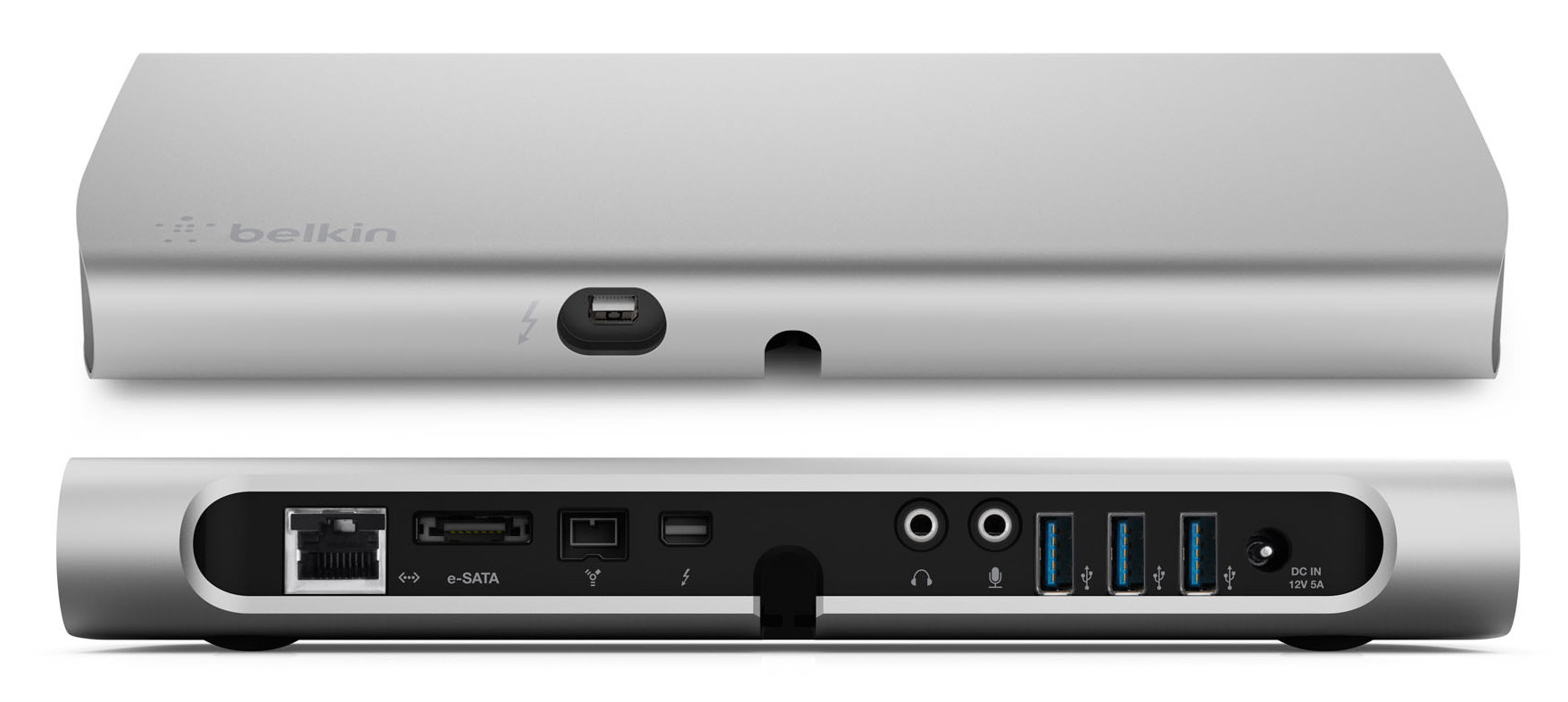
I have never liked the mass of wires sticking out of a laptop and I am glad that Apple could offer a new interface with Intel, which will easily cover each of the ports in this docking station with its bandwidth at the same time. It remains to teach him to conduct electricity for food and the price he will not.
But in the modern Apple trend there is also the fact that I, as an amateur of digging into pieces of iron, are not happy. The guys from iFixit put a new laptop 1/10 points on maintainability. What is there to say, you want to remove the cover - look for a special screwdriver, which is found only in authorized services. Not to mention the fact that replacing the SSD will be an EPIQ quest, and RAM is like arms and legs - one for life. It’s difficult to put up with such compromises and, while the computer is working without failures, you can, but my “toad” feels that soon it will choke me for Apple Care a plan without which you can get involved if something goes wrong. On the one hand, I understand that it is extremely difficult to make such a Power-house, weighing two kilograms, at the peak level of modern technologies, and it is necessary to sacrifice, but on the other hand, the backside idea does not leave that for an additional guarantee,RAM or SSD money will have to carry it to Apple and nowhere else (Well, almost ).
Findings:This update line of laptops can not be called intermediate. Unexpected, too, do not call. The novelty is quite meaningful. And at the same time, to some extent, it is ahead of its time. I mean that the Internet, for example, is not yet very ready for high-density screens, but it’s a matter of time and I’m pleased to see that this question comes up, the trend will definitely be picked up by other manufacturers and soon we will see shifts in the industry producing monitors and laptops. The fact that in the near future, all Apple computers will be equipped with Retina screens now also leaves no doubt. We are witnessing a progressive revolution, the idea that was originally embodied in the iPhone spreads its wings and in a few years it will surely fall into the category of standards on personal computers.It’s bad or good to suggest when you try to work with your usual tasks on a new screen. And it's worth a try!
Benefits:
- Retina display
- Full readiness of Mac OS to the new screen
- Excellent performance
- Compact housing with excellent build quality
- 2x USB3.0 + 2x Thunderbolt (compatible with Mini-DisplayPort)
- Full slot for SDXC-cards
- Good battery performance
Disadvantages:
- High price (from 84'000r. In Russia)
- Bulky adapters if needed FireWire and / or Ethernet
- Low maintainability and the inability to self-upgrade
Thanks for attention! I am happy to answer your questions.
Source: https://habr.com/ru/post/152855/
All Articles